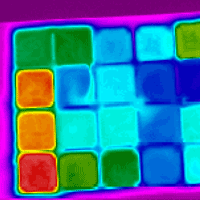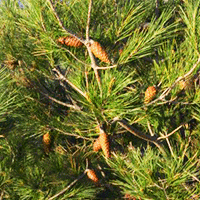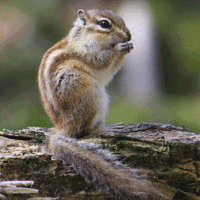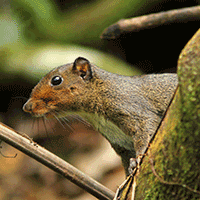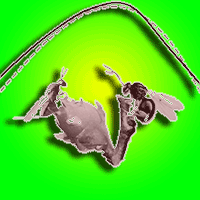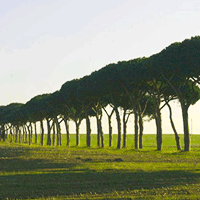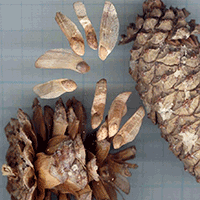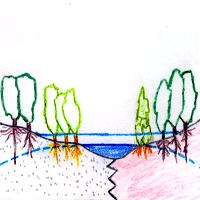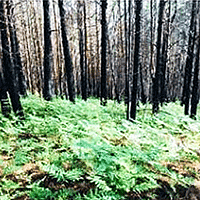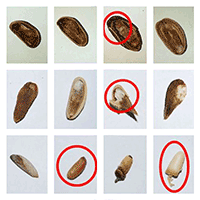
Decline in commercial pine nut and kernel yield in Mediterranean stone pine (Pinus pinea L.) in Spain
Rafael Calama (1-2) , Javier Gordo (3), Sven Mutke (1-2), Mar Conde (1), Guillermo Madrigal (1-2), Enrique Garriga (4), María José Arias (5), Míriam Piqué (6), Rodrigo Gandía (7), Gregorio Montero (1-2), Marta Pardos (1-2)
iForest - Biogeosciences and Forestry, Volume 13, Issue 4, Pages 251-260 (2020)
doi: https://doi.org/10.3832/ifor3180-013
Published: Jul 03, 2020 - Copyright © 2020 SISEF
Research Articles
Abstract
Cones of the Mediterranean stone pine (Pinus pinea L.) constitute one of the most relevant non-wood forest products collected in the Mediterranean forests, providing high value edible kernels. In the last years it has been observed a severe decline in the kernel-per-cone yield (kg of kernels obtained from a kg of fresh cones) through the whole area of the species. This decline has been associated with both ongoing climate change and the recent expansion over the Mediterranean Basin of the Western Conifer Seed Bug, Leptoglossus occidentalis Heideman, an exotic pest which predates seeds of conifer species. In the present work we aimed to confirm and quantify the impact of this recent decline on pine nut and kernel production, identify the main factors provoking this reduction, and give evidence over causality by a potential biotic agent. We analysed recent and historical series of pine nut and kernel production obtained in the four main regions where Pinus pinea occurs in Spain. Our results showed a significant drop in the final kernel-per-cone yield on three of the four regions analysed, reaching reductions over 50% in the most affected areas. We observed that this reduction is mainly associated with a significant and generalised drop in the kernel-per-nut yield (kg of kernels per kg of pine nuts in shell), triggered by an increment in the rate of damaged pine nuts and, to a lesser extent, a reduction in the number of pine nuts per cone. The prevalence of this reduction on kernel-per-cone yield over different years and provenances with contrasting climate reinforces the hypothesis of the implication of a biotic factor which can be aggravated on extreme drought years.
Keywords
Leptoglossus occidentalis, Kernel-per-cone Yield, Cones, Exotic Pest, Seed Predation
Authors’ Info
Authors’ address
Sven Mutke 0000-0002-6365-7128
Mar Conde
Guillermo Madrigal
Gregorio Montero
Marta Pardos 0000-0002-5567-5406
INIA - Forest Research Centre, Dept. of Forest Management and Dynamics, Ctra A Coruña km 7.5, 28040 Madrid (Spain)
Sven Mutke 0000-0002-6365-7128
Guillermo Madrigal
Gregorio Montero
Marta Pardos 0000-0002-5567-5406
iuFOR, Sustainable Forest Management Research Institute, UVa-INIA (Spain)
INIA - Forest Research Centre, Dept. of Forest Products, Ctra A Coruña km 7.5, 28040 Madrid (Spain)
Dept. of Forest Products, INIA-CIFOR, Ctra A Coruña km 7.5, 28040 Madrid (Spain)
Agencia de Medio Ambiente y Agua de Andalucía, c/ Johan G. Gutenberg, 41092 Sevilla (Spain)
Servicio Territorial de Medio Ambiente de Ávila, Pasaje del Císter 1, 05071 Ávila (Spain)
Corresponding author
Paper Info
Citation
Calama R, Gordo J, Mutke S, Conde M, Madrigal G, Garriga E, Arias MJ, Piqué M, Gandía R, Montero G, Pardos M (2020). Decline in commercial pine nut and kernel yield in Mediterranean stone pine (Pinus pinea L.) in Spain. iForest 13: 251-260. - doi: 10.3832/ifor3180-013
Academic Editor
Massimo Faccoli
Paper history
Received: Jun 28, 2019
Accepted: Apr 29, 2020
First online: Jul 03, 2020
Publication Date: Aug 31, 2020
Publication Time: 2.17 months
Copyright Information
© SISEF - The Italian Society of Silviculture and Forest Ecology 2020
Open Access
This article is distributed under the terms of the Creative Commons Attribution-Non Commercial 4.0 International (https://creativecommons.org/licenses/by-nc/4.0/), which permits unrestricted use, distribution, and reproduction in any medium, provided you give appropriate credit to the original author(s) and the source, provide a link to the Creative Commons license, and indicate if changes were made.
Web Metrics
Breakdown by View Type
Article Usage
Total Article Views: 47023
(from publication date up to now)
Breakdown by View Type
HTML Page Views: 38084
Abstract Page Views: 5190
PDF Downloads: 2921
Citation/Reference Downloads: 14
XML Downloads: 814
Web Metrics
Days since publication: 2016
Overall contacts: 47023
Avg. contacts per week: 163.27
Citation Metrics
Article Citations
Article citations are based on data periodically collected from the Clarivate Web of Science web site
(last update: Mar 2025)
Total number of cites (since 2020): 24
Average cites per year: 4.00
Publication Metrics
by Dimensions ©
Articles citing this article
List of the papers citing this article based on CrossRef Cited-by.
References
Cadeia de valor da fileira da pinha/pinhao [Chain value for the pine nut/pine cone sector]. UNAC, Lisboa, Portugal, pp. 119. [in Portuguese]
Gscholar
Modelling spatial and temporal variability on Stone pine (Pinus pinea L.) cone quality: preliminary results. In: “EFIMED Scientific Seminar: Modelling, Valuing and Managing Mediterranean Forest Ecosystem for Non-Timber Goods and Services”. Palencia (Spain) 10 Oct 2007, Oral Presentation, pp. 22.
Online | Gscholar
Pérdidas de rendimiento en piñón en piñas de Pinus pinea L.: análisis interregional [Decline in kernel and pine nut yields in Pinus pinea L. cones: an interregional analysis]. III Reunión Científica de Sanidad Forestal SECF. Madrid (Spain) 7-8 Oct 2015. [in Spanish]
Online | Gscholar
Pine nut damage on inmature cones of Pinus pinea L.: evidences for Leptoglossus causality. In: Proceedings of the “2nd International Meeting on Mediterranean Stone Pine for Agroforestry - Agropine 2016”. Oeiras (Portugal) 18-20 May 2016. INIAV, Oeiras, Portugal, pp. 38-39.
Gscholar
Variabilidad espacio-temporal en el daño asociado a Leptoglossus occidentalis en pinares de Pinus pinea de la provincia de Valladolid [Spatiotemporal variability in the damage by Leptoglossus occidentailis in Pinus pinea forests in the province of Valladolid]. In: Proceedings of the “7° Congreso Forestal Español”. Plasencia (Spain) 26-30 Jun 2017. Sociedad Española de Ciencias Fisiológicas - SECF, Spain, pp. 482. [in Spanish]
Gscholar
Damage assessment in pine nuts from stone pine caused by Leptoglossus occidentalis and pathogenic agents. In: Proceedings of the Meeting “Wild Forest Products in Europe”. Barcelona (Spain) 13-14 Oct 2016, Poster.
Online | Gscholar
Micro X-ray computed tomography suggests cooperative feeding among adult invasive bugs Leptoglossus occidentalis on mature seeds of stone pine Pinus pinea. Agriculture and Forest Entomology 20 (1): 18-27.
CrossRef | Gscholar
Silvicultural guidelines for managing P. pinea stands in a southeastern Portuguese region for cone production. Revised silvicultural guidelines for selected MPT and NWFPs. StarTree Deliverable 2.3, FP7 Project no 311919 KBBE 2012 (1): 2-06. European Commission, Brussels, Belgium, pp. 58-70.
Gscholar
El pino piñonero (Pinus pinea L.) [The Stone pine]. In: “Mejora genética y masas productoras de semilla de los pinares españoles” (Alía R, Galera R, Martín S eds). INIA, Madrid, Spain, pp. 223-239. [in Spanish]
Gscholar
Establecimiento de plantaciones clonales de Pinus pinea para la producción de piñón mediterráneo [Estabishing clonal plantations with Pinus pinea to promote pine nut production]. Monografías INIA 28, Madrid, Spain, pp. 80. [in Spanish]
Gscholar
El pino piñonero (Pinus pinea L.) en Andalucía: ecología, distribución y selvicultura [Stone pine (Pinus pinea L.) in Andalusia: ecology, distribution and silviculture]. Junta de Andalucía, Sevilla, Spain, pp. 261. [in Spanish]
Gscholar
Modelos para la predicción del contenido y calidad de piñón en piñas de Pinus pinea L. en los Valles del Tiétar y del Alberche [Empirical model for predicting pine nut content and quality in Pinus pinea L. cones from Tietar and Alberche Valleys]. MSc thesis, ETSI Montes, Universidad Politécnica de Madrid, Madrid, Spain, pp. 149. [in Spanish]
Gscholar
Guidelines for integrated management of sustainable pine forests. Paper no. TCP/LEB/3501, FAO/Ministry of Agriculture, Beirut, Lebanon, pp. 48. [in Arabic]
Gscholar
Daños estacionales a piñas y piñones de Pinus pinea de diferentes edades causados por Leptoglossus occidentalis Heidemann (Heteroptera, Coreidae) [Stational damage in P. pinea cones and pine nuts provoked by Leptoglossus occidentalis Heidemann (Heteroptera, Coreidae)]. In: Proceedings of the “7° Congreso Forestal Español”. Plasencia (Spain) 26-30 Jun 2017. Sociedad Española de Ciencias Fisiológicas - SECF, Spain, pp. 463. [in Spanish]
Gscholar
Regiones de procedencia de Pinus pinea [Provenance regions for Pinus pinea]. Ministerio de Medio Ambiente, Madrid, Spain, pp. 109. [in Spanish]
Gscholar
Sanidade dos povoamentos de pinheiro manso em Portugal [Health state of Pinus pinea forests in Portugal]. In: Proceedings of the Meeting “Valorização da Fileira da Pinha/Pinhão” (Calado N ed). Alcácer do Sal (Portugal) Sept 2012. Oral presentation, pp. 36. [in Portuguese]
Online | Gscholar
Danni alla fruttificazione del Pino Domestico: indagine sulle cause e sulle perdite di produzione [Damage to Stone pine fruiting: findings on main cause and losses ofproduction]. Technical Report, Arsia - University of Firenze - Regione Toscana, Florence, Italy, pp. 19. [in Italian]
Gscholar
Aplicación de las TIG para la determinación de la influencia del paisaje en Leptoglossus occidentalis (Hemiptera: Coreidae) en pinares de la provincia de Valladolid [Applying GIS to determine the effect of landscape structure on Leptoglossus occidentalis (Hemiptera: Coreidae) behaviour in pinewood of Valladolid province]. MSc Thesis, Faculty of Geography, Universidad Complutense de Madrid, Madrid, Spain, pp. 61. [in Spanish]
Gscholar

